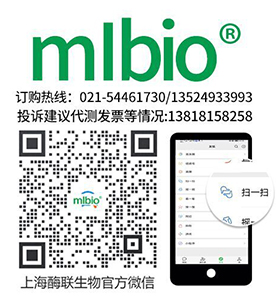产品货号 : mlR16645
英文名称 : Influenza A Neuraminidase 1
中文名称 : A型流感病毒H5N1神经氨酸酶1抗体
别 名 : NRAM_I97A1; H5N1 Neuraminidase 1.
研究领域 : 细菌及病毒
抗体来源 : Rabbit
克隆类型 : Polyclonal
交叉反应 : Influenza A
产品应用 : WB=1:500-2000 ELISA=1:500-1000 IHC-P=1:400-800 IHC-F=1:400-800 ICC=1:100-500 IF=1:100-500 (石蜡切片需做抗原修复)
not yet tested in other applications.
optimal dilutions/concentrations should be determined by the end user.
分 子 量 : 49kDa
细胞定位 : 细胞膜
性 状 : Lyophilized or Liquid
浓 度 : 1mg/ml
免 疫 原 : KLH conjugated synthetic peptide derived from Influenza A H5N1 Neuraminidase 1:301-400/450
亚 型 : IgG
纯化方法 : affinity purified by Protein A
储 存 液 : 0.01M TBS(pH7.4) with 1% BSA, 0.03% Proclin300 and 50% Glycerol.
保存条件 : Store at -20 °C for one year. Avoid repeated freeze/thaw cycles. The lyophilized antibody is stable at room temperature for at least one month and for greater than a year when kept at -20°C. When reconstituted in sterile pH 7.4 0.01M PBS or diluent of antibody the antibody is stable for at least two weeks at 2-4 °C.
PubMedPubMed
产品介绍background:
Influenza A virus is a major public health threat, killing more than 30,000 people per year in the USA (1). Novel influenza virus strains emerge periodically to which humans have little or no immunity, resulting in devastating pandemics. Influenza A can exist in a variety of animals; however it is in birds that all subtypes can be found (2). These subtypes are classified based on the combination of the virus coat glycoproteins hemagglutinin (HA) and neuraminidase (NA) subtypes. During 1997, an H5N1 avian influenza virus was determined to be the cause of death in 6 of 18 infected patients in Hong Kong (3). There was some evidence of human to human spread of this virus, but it is thought that the transmission efficiency was fairly low (4). Although it has been known that cleavage site and glycosylation patterns of the HA protein play important roles in determining the pathogenicity of H5 avian influenza viruses, it has only recently been shown that an additional glycosylation site within the globular head of the NA protein also contributes to the high virulence of the H5N1 virus (5).
Function:
Catalyzes the removal of terminal sialic acid residues from viral and cellular glycoconjugates. Cleaves off the terminal sialic acids on the glycosylated HA during virus budding to facilitate virus release. Additionally helps virus spread through the circulation by further removing sialic acids from the cell surface. These cleavages prevent self-aggregation and ensure the efficient spread of the progeny virus from cell to cell. Otherwise, infection would be limited to one round of replication. Described as a receptor-destroying enzyme because it cleaves a terminal sialic acid from the cellular receptors. May facilitate viral invasion of the upper airways by cleaving the sialic acid moities on the mucin of the airway epithelial cells. Likely to plays a role in the budding process through its association with lipid rafts during intracellular transport. May additionally display a raft-association independent effect on budding. Plays a role in the determination of host range restriction on replication and virulence. Sialidase activity in late endosome/lysosome traffic seems to enhance virus replication.
Subunit:
Homotetramer.
Subcellular Location:
Virion membrane. Host apical cell membrane; Single-pass type II membrane protein. Note=Preferentially accumulates at the apical plasma membrane in infected polarized epithelial cells, which is the virus assembly site. Uses lipid rafts for cell surface transport and apical sorting. In the virion, forms a mushroom-shaped spike on the surface of the membrane.
Post-translational modifications:
N-glycosylated.
Similarity:
Belongs to the glycosyl hydrolase 34 family.
Gene ID:
3654619
Important Note:
This product as supplied is intended for research use only, not for use in human, therapeutic or diagnostic applications.











